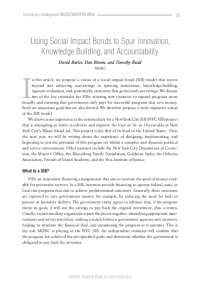Using Social Impact Bonds to Spur Innovation, Knowledge-Building, and Accountability
In this article, first published in a special issue of the Federal Reserve Bank of San Francisco’s Community Development Investment Review, we propose a vision of a social impact bond (SIB) model that moves beyond just achieving cost-savings to spurring innovation, knowledge-building, rigorous evaluation, and, potentially, outcomes that go beyond cost savings. We discuss two of the key rationales for SIBs: securing new resources to expand programs more broadly and ensuring that government only pays for successful programs that save money. Both are important goals but are also limited. We therefore propose a more expansive vision of the SIB model.
We draw on our experience as the intermediary for a New York City SIB (NYC SIB) project that is attempting to lower recidivism and improve the lives of 16- to 18-year-olds in New York City’s Rikers Island jail. This project is the first of its kind in the United States. Over the next year, we will be writing about the experience of designing, implementing, and beginning to test the potential of this program set within a complex and dynamic political and service environment. Other partners include the New York City Department of Correction, the Mayor’s Office, the Bloomberg Family Foundation, Goldman Sachs, the Osborne Association, Friends of Island Academy, and the Vera Institute of Justice.
What Is a SIB?
SIBs are innovative financing arrangements that aim to increase the pool of money available for preventive services. In a SIB, investors provide financing to operate federal, state, or local-run programs that aim to achieve predetermined outcomes. Generally, these outcomes are expected to save government money, for example, by reducing the need for beds in prisons or homeless shelters. The government entity agrees in advance that, if the program meets its goals, it will use the savings to pay back the original investment, plus a return. Usually, an intermediary organization puts the pieces together — identifying appropriate interventions and service providers, making a match between government agencies and investors, helping to structure the financial deal, and monitoring the program as it operates. This is the role MDRC is playing in the NYC SIB. An independent evaluator will confirm that the program has achieved the pre-specified goals and determine whether the government is obligated to pay back the investors.







